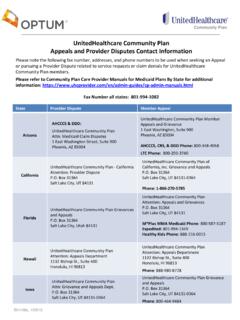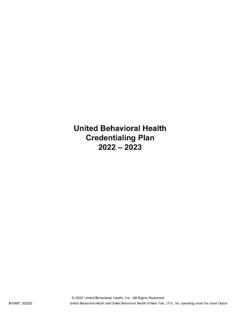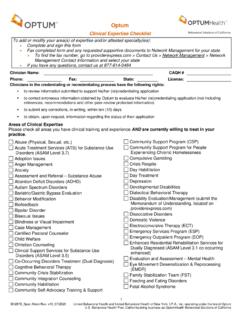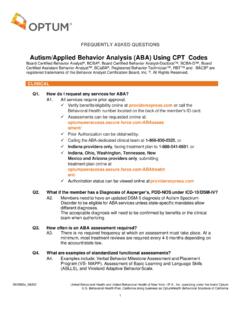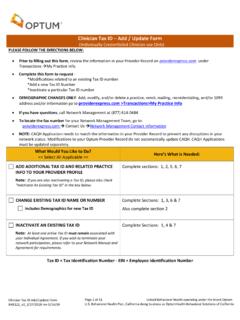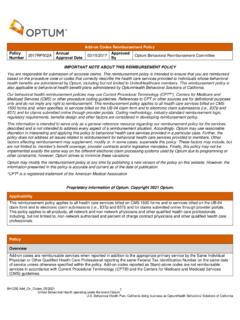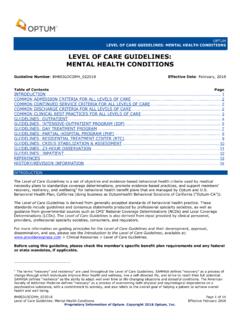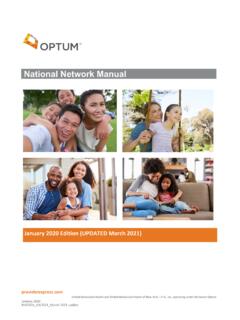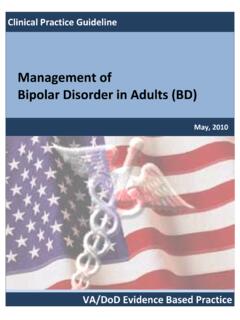Transcription of OTHER AND UNSPECIFIED DISORDERS - Provider Express
1 Proprietary Information of Optum. Copyright 2020 Optum, Inc. United Behavioral HealthCoverage Determination Guideline: OTHER and UNSPECIFIED DISORDERS Document Number: BH803 OUD032020 Effective Date: March 16, 2020 Table of Contents Introduction Instructions for Use Benefit Considerations Coverage Rationale Applicable Codes References Revision History Coverage Determination Guidelines are a set of objective and evidence-based behavioral health criteria used by Commercial plans that don t have a provision for medical necessity to standardize coverage determinations, promote evidence-based practices, and support members recovery, resiliency, and wellbeing for behavioral health benefit plans that are managed by Optum 1.
2 This guideline provides assistance in interpreting UnitedHealthcare Commercial benefit plans, and is used to make coverage determinations as well as to inform discussions about evidence-based practices and discharge planning for behavioral health benefit plans managed by Optum. When deciding coverage, the member s specific benefits must be referenced. All reviewers must first identify member eligibility, the member-specific benefit plan coverage, and any federal or state regulatory requirements that supersede the member s benefits prior to using this guideline. In the event that the requested service or procedure is limited or excluded from the benefit, is defined differently or there is otherwise a conflict between this guideline and the member s specific benefit, the member s specific benefit supersedes this guideline.
3 OTHER clinical criteria may apply. Optum reserves the right, in its sole discretion, to modify its clinical criteria as necessary using the process described in Clinical Criteria. This guideline is provided for informational purposes. It does not constitute medical advice. Optum may also use tools developed by third parties that are intended to be used in connection with the independent professional medical judgment of a qualified health care Provider and do not constitute the practice of medicine or medical advice. Optum may develop clinical criteria or adopt externally-developed clinical criteria that supersede this guideline when required to do so by contract or regulation.
4 Before using this policy, please check the member-specific benefit plan document and any federal or state mandates, if applicable. Optum is a brand used by United Behavioral Health and its affiliates. Page 2 of 6 Available benefits for OTHER and UNSPECIFIED DISORDERS include the following levels of care, procedures, and conditions: Levels of Care o Inpatient o Intensive Outpatient Program o Outpatient o Partial Hospital Program o Residential Treatment Facility Procedures o Diagnosis, evaluation, assessment, and treatment planning o Treatment and/or procedures o Medication management and OTHER associated treatments o Individual, family, and group therapy o Provider -based case management o Crisis intervention Conditions o Depressive DISORDERS classified in the current edition of the International Classification of Diseases section on Mental and Behavioral DISORDERS or Diagnostic and Statistical Manual of the American Psychiatric Association that are not excluded from coverage.
5 Effective and efficient treatment is facilitated by the clarity and accuracy of the diagnosis. An OTHER Specified or UNSPECIFIED diagnosis is used when a comprehensive evaluation and further diagnostic specificity is not possible. Clinicians assign these diagnoses when there are diagnostic features of a disorder within a diagnostic class but the presenting signs, symptoms and features do not meet the full criteria for a specific disorder. The OTHER Specified Disorder category allows the clinician to communicate the specific reason that the presentation does not meet the criteria for any specific category within a diagnostic class. This is done by recording the name of the category, followed by the specific reason (Diagnostic and Statistical Manual of Mental DISORDERS , 5th ed.)
6 ; DSM-5; American Psychiatric Association, , 2013). The following is an example of OTHER and UNSPECIFIED DISORDERS : A member has clinically significant depressive symptoms lasting 4 weeks but symptomatology falls short of the diagnostic threshold for a major depressive episode, then the clinician would record OTHER Specified Depressive Disorder, depressive episode with insufficient symptoms (DSM-5, p. 15, 2013). The use of the UNSPECIFIED Disorder as defined in the current edition of the Diagnostic and Statistical Manual of the American Psychiatric Association is excluded. It is given when the clinician does not specify the reason that the criteria are not met within a diagnostic class.
7 (DSM-5, p. 16, 2013). The following is an example of a circumstance under which mental health treatment for OTHER and UNSPECIFIED DISORDERS are excluded: In an emergency department setting, only the most prominent symptom expressions associated with a particular category are identified ( , delusions, hallucinations, mania, depression, anxiety, or substance intoxication) rather than assigning the OTHER Specified Disorder (DSM-5, p. 20, 2013). Benefits are available for covered services that are not otherwise limited or excluded. Indications for Coverage The requested service or procedure must be reviewed against the language in the member's benefit document.
8 When the requested service or procedure is limited or excluded from the member s benefit document, or is otherwise defined differently, it is the terms of the member's benefit document that prevails. Page 3 of 6 Per the specific requirements of the plan, health care services or supplies may not be covered when inconsistent with generally accepted standards and clinical guidelines. A. Initial evaluation Optum recognizes the American Psychiatric Association s Practice Guidelines for the Psychiatric Evaluation of Adults (2016): o > Psychiatrists > Practice > Clinical Practice Guidelines When establishing a diagnosis, consider the following: o An OTHER Specified or UNSPECIFIED diagnosis is not the same as a provisional diagnosis.
9 A provisional diagnosis ( working diagnosis ) is given when there is limited information that prevents a clinician from establishing a firm principal DSM diagnosis. A provisional diagnosis is applied when: There is a strong presumption that the full criteria of a DSM classified disorder will ultimately be met, but not enough information is available to determine a diagnosis ( , a full history is needed to establish if full criteria are met) (DSM-5, p. 23, 2013). Differential diagnosis is dependent exclusively on the duration of the illness ( , remission cannot be confirmed until 6 months has lapsed) (DSM-5, p. 23, 2013). o Carefully differentiate symptoms that support an OTHER Specified or UNSPECIFIED diagnosis from those that: Support a provisional diagnosis ; or Meet the full criteria for a specific disorder.
10 Further assessment should confirm whether the member s symptoms continue to warrant an OTHER Specified or UNSPECIFIED diagnosis ( , there, is uncertainty about whether the symptoms are substance induced or due to a general medical condition, there is insufficient opportunity to complete data collection, or there is inconsistent or contradictory information). Coverage for an OTHER Specified may be indicated when: o The member s diagnosis meets the DSM definition of a OTHER Specified Disorder or UNSPECIFIED Disorder ; o The member s diagnosis does not meet the full criteria for a specific disorder; o There will be further assessment to confirm whether the member s symptoms continue to warrant an OTHER Specified diagnosis due to: Uncertainty about whether the symptoms are substance induced or due to a general medical condition, Insufficient opportunity to complete data collection, or Inconsistent or contradictory information.
